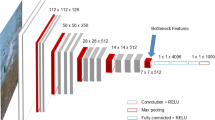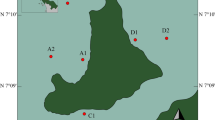Abstract
Irrespective of how plastics litter the coastline or enter the sea, they pose a major threat to birds and marine life alike. In this study, an artificial intelligence tool was used to create an image classifier based on a convolutional neural network architecture that utilises the bottleneck method. The trained bottleneck method classifier was able to categorise plastics encountered either at the shoreline or floating at the sea surface into eight distinct classes, namely, plastic bags, bottles, buckets, food wrappings, straws, derelict nets, fish, and other objects. Discerning objects with a success rate of 90%, the proposed deep learning approach constitutes a leap towards the smart identification of plastics at the coastline and the sea. Training and testing loss and accuracy results for a range of epochs and batch sizes have lent credibility to the proposed method. Results originating from a resolution sensitivity analysis demonstrated that the prediction technique retains its ability to correctly identify plastics even when image resolution was downsized by 75%. Intelligent tools, such as the one suggested here, can replace manual sorting of macroplastics from human operators revealing, for the first time, the true scale of the amount of plastic polluting our beaches and the seas.











Similar content being viewed by others
References
Algalita (2014) Algalita videos and images acquired during marine expeditions of the ORV Alguita vessel
Andrady AL (2011) Microplastics in the marine environment. Mar Pollut Bull 62:1596–1605
Barboza LGA, Dick Vethaak A, Lavorante BRBO, Lundebye A-K, Guilhermino L (2018) Marine microplastic debris: an emerging issue for food security, food safety and human health. Mar Pollut Bull 133:336–348
Barnes DKA, Galgani F, Thompson RC, Barlaz M (2009) Accumulation and fragmentation of plastic debris in global environments. Philos Trans R Soc B 364:1985–1998
Ciodaro T, Deva D, de Seixas JM, Damazio D (2012) Online particle detection with neural networks based on topological calorimetry information. J Phys Conf Ser 368:012030
Cole M, Lindeque P, Halsband C, Galloway TS (2011) Microplastics as contaminants in the marine environment: a review. Mar Pollut Bull 62:2588–2597
Corcoran PL, Biesinger MC, Grifi M (2009) Plastics and beaches: a degrading relationship. Mar Pollut Bull 58:80–84
Cózar A, Echevarría F, González-Gordillo JI, Irigoien X, Úbeda B, Hernández-León S, Palma ÁT, Navarro S, García-de-Lomas J, Ruiz A, Fernández-de-Puelles ML, Duarte CM (2014) Plastic debris in the open ocean. Proc Natl Acad Sci USA 111:10239–10244
Cózar A, Sanz-Martín M, Martí E, González-Gordillo JI, Ubeda B, Gálvez JÁ, Irigoien X, Duarte CM (2015) Plastic accumulation in the Mediterranean Sea. PLoS One 10:1–12
Eriksen M, Lebreton LCM, Carson HS, Thiel M, Moore CJ, Borerro JC, Galgani F, Ryan PG, Reisser J (2014) Plastic pollution in the world's oceans: more than 5 trillion plastic pieces weighing over 250,000 tons afloat at sea. PLoS One 9:1–15
FAO (2018): The state of world fisheries and aquaculture 2018—meeting the sustainable development goals, Rome
Farabet C, Couprie C, Najman L, LeCun Y (2013) Learning hierarchical features for scene labeling. IEEE Trans Pattern Anal 35:1915–1929
Fulton M, Hong J, Islam MJ, Sattar J (2019) Robotic detection of marine litter using deep visual detection models, 2019 IEEE Int. Conf. Robot., pp. 5752-5758
Galgani F, Hanke G, Werner S, De Vrees L (2013) Marine litter within the European Marine Strategy Framework Directive. ICES J Mar Sci 70:1055–1064
Gallo F, Fossi C, Weber R, Santillo D, Sousa J, Ingram I, Nadal A, Romano D (2018) Marine litter plastics and microplastics and their toxic chemicals components: the need for urgent preventive measures. Environ Sci Eur 30:13
Ge Z, Shi H, Mei X, Dai Z, Li D (2016) Semi-automatic recognition of marine debris on beaches. Sci Rep 6:25759
Goldstein MC, Titmus AJ, Ford M (2013) Scales of spatial heterogeneity of plastic parine debris in the Northeast Pacific Ocean. PLoS One 8:e80020
González-Fernández D, Hanke G (2017) Toward a harmonized approach for monitoring of riverine floating macro litter inputs to the marine environment. Front Mar Sci 4
Goodfellow I, Bengio Y, Courville A (2016) Deep learning. The MIT Press
Helmstaedter M, Briggman KL, Turaga SC, Jain V, Seung HS, Denk W (2013) Connectomic reconstruction of the inner plexiform layer in the mouse retina. Nature 500:168–174
Hinton G, Deng L, Yu D, Dahl GE, Mohamed A, Jaitly N, Senior A, Vanhoucke V, Nguyen P, Sainath TN, Kingsbury B (2012) Deep neural networks for acoustic modeling in speech recognition: the shared views of four research groups. IEEE Signal Proc Mag 29:82–97
Jambeck JR, Geyer R, Wilcox C, Siegler TR, Perryman M, Andrady A, Narayan R, Law KL (2015) Plastic waste inputs from land into the ocean. Science 347:768–771
Krizhevsky A, Sutskever I, Hinton GE (2012) ImageNet classification with deep convolutional neural networks, Proceedings of the 25th International Conference on Neural Information Processing Systems—Volume 1. Curran Associates Inc., Lake Tahoe, Nevada, pp 1097–1105
Kulkarni S, Junghare S (2013) Robot based indoor autonomous trash detection algorithm using ultrasonic sensors, 2013 International Conference on Control, Automation, Robotics and Embedded Systems (CARE), pp. 1–5
Kylili K, Artusi A, Kyriakides I, Hadjistassou C (2018) Tracking and identifying floating marine debris, Sixth International Marine Debris Conference, San Diego
Kylili K, Kyriakides I, Artusi A, Hadjistassou C (2019) Identifying floating plastic marine debris using a deep learning approach. Environ Sci Pollut Res 26:17091–17099
Lebreton L, Slat B, Ferrari F, Sainte-Rose B, Aitken J, Marthouse R, Hajbane S, Cunsolo S, Schwarz A, Levivier A, Noble K, Debeljak P, Maral H, Schoeneich-Argent R, Brambini R, Reisser J (2018) Evidence that the Great Pacific Garbage Patch is rapidly accumulating plastic. Sci Rep 8:4666
LeCun Y, Bengio Y, Hinton G (2015) Deep learning. Nature 521:436–444
Lusher AL, O'Donnell C, Officer R, O'Connor I (2015) Microplastic interactions with North Atlantic mesopelagic fish. ICES J Mar Sci 73:1214–1225
Mace TH (2012) At-sea detection of marine debris: overview of technologies, processes, issues, and options. Mar Pollut Bull 65:23–27
Mikolov T, Deoras A, Povey D, Burget L, Cernocky J (2011): Strategies for training large scale neural network language models. 2011 IEEE Workshop on Automatic Speech Recognition and Understanding, ASRU 2011, Proceedings
Moy K, Neilson B, Chung A, Meadows A, Castrence M, Ambagis S, Davidson K (2018) Mapping coastal marine debris using aerial imagery and spatial analysis. Mar Pollut Bull 132:52–59
National Oceanic and Atmospheric Administration (NOAA) 2015: Detecting Japan tsunami marine debris at sea: a synthesis of efforts and lessons learned
National Oceanic and Atmospheric Administration (NOAA) (2018) NOAA Photo Library, Online: https://photolib.noaa.gov/
Nelms SE, Duncan EM, Broderick AC, Galloway TS, Godfrey MH, Hamann M, Lindeque PK, Godley BJ (2015) Plastic and marine turtles: a review and call for research. ICES J Mar Sci 73:165–181
Newman P, Crawley A (2014) Plastic, ahoy!: investigating the great Pacific garbage patch. Lerner Publishing Group
Pierdomenico M, Casalbore D, Chiocci FL (2019) Massive benthic litter funnelled to deep sea by flash-flood generated hyperpycnal flows. Sci Rep 9:5330
PlasticsEurope (2017) Plastics – the Facts:2017
PlasticsEurope (2018a) Annual Review 2017–2018
PlasticsEurope (2018b) Plastics – the Facts 2018
Redmon J, Farhadi A (2018) Yolov3: an incremental improvement. arXiv preprint arXiv:1804.02767
Ruiz-Orejon LF, Sarda R, Ramis-Pujol J (2016) Floating plastic debris in the Central and Western Mediterranean Sea. Mar Environ Res 120:136–144
Sainath TN, Mohamed A, Kingsbury B, Ramabhadran B (2013) Deep convolutional neural networks for LVCSR, 2013 IEEE Int. Conf. Acoust Speech, pp. 8614-8618
Simonyan K, Zisserman A (2014) Very Deep Convolutional Networks for large-scale image recognition arXiv:1409.1556
Suaria G, Aliani S (2014) Floating debris in the Mediterranean Sea. Mar Pollut Bull 86:494–504
Szegedy C, Wei L, Yangqing J, Sermanet P, Reed S, Anguelov D, Erhan D, Vanhoucke V, Rabinovich A (2015) Going deeper with convolutions, 2015 IEEE Proc. CVPR, pp 1–9
Tompson J, Jain A, Lecun Y, Bregler C (2014) Joint training of a convolutional network and a graphical model for human pose estimation. arXiv
Valdenegro-Toro M (2016) Submerged marine debris detection with autonomous underwater vehicles, 2016 International Conference on Robotics and Automation for Humanitarian Applications (RAHA), pp. 1-7
Woodall LC, Sanchez-Vidal A, Canals M, Paterson GLJ, Coppock R, Sleight V, Calafat A, Rogers AD, Narayanaswamy BE, Thompson RC (2014) The deep sea is a major sink for microplastic debris. Roy Soc Open Sci 1
Acknowledgements
The authors would like to thank Algalita non-profit organisation for kindly sharing with us marine debris images and videos acquired during their boat expeditions.
Funding
K. K. acknowledges financial support from the A. G. Leventis Foundation. A. A.’s work is financially supported by the European Union, Horizon 2020 research and innovation programme under grant agreement no. 739578 also complemented by the Government of the Republic of Cyprus through the Directorate General for European Programmes, Coordination and Development.
Author information
Authors and Affiliations
Corresponding author
Additional information
Responsible Editor: Philippe Garrigues
Publisher’s note
Springer Nature remains neutral with regard to jurisdictional claims in published maps and institutional affiliations.
Rights and permissions
About this article
Cite this article
Kylili, K., Hadjistassou, C. & Artusi, A. An intelligent way for discerning plastics at the shorelines and the seas. Environ Sci Pollut Res 27, 42631–42643 (2020). https://doi.org/10.1007/s11356-020-10105-7
Received:
Accepted:
Published:
Issue Date:
DOI: https://doi.org/10.1007/s11356-020-10105-7




